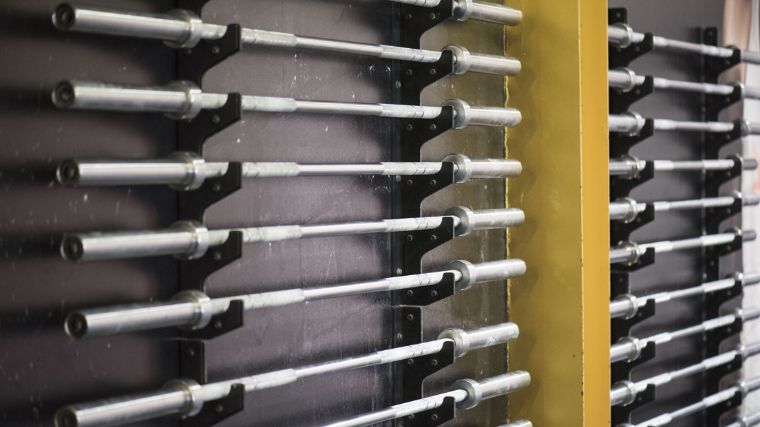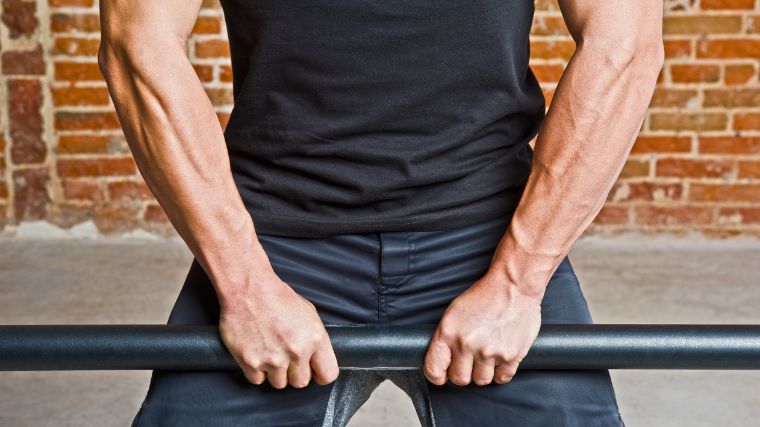An average conversation between strength sports enthusiasts often includes questions about numbers: How much do you bench? What’s your one-rep max with the clean & jerk? Answering those questions isn’t just about counting up the weight plates on the bar. You’ll also have to know how much a barbell weighs to answer.
But asking, “How much does a barbell weigh?” will yield different responses depending on who you ask and what exercise you’re thinking about. For instance, if you have a chat with some powerlifting purists, you shouldn’t be surprised if they tell you that there is only one true lifting bar and that it only has one legitimate weight.

But there are a lot of different types of barbells out there, possessing a multitude of physical dimensions, which have been manufactured with many different intentions in mind. So, let’s identify the barbells you are most likely to come across in your fitness adventures, figure out how much they weigh, and then select the best option to fulfill each of your workout goals.
Different Types of Barbells
Even in the earliest eras of fitness, there were several types of barbells of many different weights. Modern barbell selection has even more diversity to it than it did in the late 1800s when the like of Eugen Sandow. No matter what the specific goals of your training are, there is likely to be a bar with a weight and other specifications that adequately accommodate your needs.
Standard Bar
This is the ubiquitous barbell that’s present in many home gyms. It’s always one inch thick, meaning you can’t use Olympic plates for it (which have two-inch holes). These bars often have a knurled surface in the area where the hands most commonly clasp it.
[Read More: 7 Barbell Back Exercises That Are NOT the Deadlift]
The standard bar also tends to have some variance to the surface of its ends where the plates slide onto it. It can have smooth ends onto which the plates are fastened with clasps or threaded ends that collars are screwed onto.
Olympic Bar
The Olympic bar is often the image that pops into most people’s heads when they picture a barbell awaiting use at the gym. This straight bar forms the quintessential bedrock of competitive equipment in weightlifting and powerlifting. Its length, width, and weight are normalized across gyms around the world.
Women’s Bar
What is deemed to be a women’s bar is truly just a slightly smaller version of an Olympic bar. Despite its name, this bar can be advantageous to lifters of all genders depending on their objectives. The bar is slightly shorter than a traditional Olympic bar but fits Olympic plates. It has a one-inch shaft diameter that is identical to that of a standard bar.
Fixed Bar
If biceps curling is a favorite at your gym but weight plates are less abundant, you may notice a rack full of fixed bars. These barbells are permanently set at a predetermined weight.

This makes them a common feature at commercial gyms, where they are unlikely to go wandering off with the members. They also negate much of the need for gyms to maintain stockpiles of the smallest weight plates.
EZ-Curl Bar
While traditional barbells are straight, EZ-curl bars are angled in one or more places along their length. These ergonomic curves normally occur at the points where hands are likely to grasp the bar during sets of exercises like curls, upright rows, and lying tricep extensions.
EZ-curl bars are often found at commercial gyms, fixed in the same manner as straight bars. However, they are also often compatible with Olympic plates so that they can be loaded according to your needs and goals.
Trap Bar
Living up to its name, the trap bar requires you to step inside of its hexagonal frame. It allows you to stand within the center of gravity of the weight being hoisted without having to counterbalance the weight.
The trap bar enables you to complete exercises like deadlifts, shrugs, and farmer’s carries with a neutral grip, which is the natural hand position for many people.
Cambered Bar
Definitions of this bar may vary depending on who you ask, but a cambered bar most commonly refers to a bar with a prominent central elevation point within which the user’s body is intended to fit during lifts.
On the small end, cambered bars on the small end of the spectrum provide additional space for greater elbow descent or elevation during bench presses and barbell rows, respectively. Conversely, larger cambered bars provide the user with a more favorable hand position during exercises like squats.
Axle Bar
The axle bar is thicker than the conventional barbell. This means that bench pressing, overhead pressing, deadlifting, and other grip-oriented moves will be more challenging. You’ll be grasping and controlling a cylindrical handle of greater width.

There is a tradeoff, though: the axle bar is lighter than an Olympic bar despite possessing a thicker handle.
Safety Bar
If you think this bar bears a strong resemblance to a deeply cambered bar, you’d be correct. The feature that sets this bar apart from its cambered cousin is the addition of a padded middle section with forward-facing handles.
This bar is designed almost exclusively with squatting in mind. It’s intended to make challenging squat reps as comfortable as possible.
Log Bar
Closely resembling its namesake — and occasionally composed of wood just like a freshly fallen tree trunk — the log bar is a common training tool for strongman events. Even if you’re not a strongman competitor, simply training with this beast of a bar will have you feeling superheroic.
Swiss Bar
Also frequently referred to as a multi-grip bar, the Swiss bar offers its users a series of hand-position options along its length. Keep in mind that not all Swiss bars are the same, and there can be a lot of variance in the number of neutral and angled handles offered by different versions.
Elephant Bar
Built with deadlifting in mind, the elephant bar is longer than an Olympic bar and extends the weight further out from the lifter. Because of this, the bar bends earlier in the lift and enables the individual plates to leave the ground at slightly different intervals.
In short, the distance that the full weight is required to travel is reduced. This allows lifters to achieve slightly more momentum before they are pulling the full quantity of load.
Buffalo/Duffalo/Yukon Bar
This is a specialty cambered barbell with a slight curve running throughout nearly all of its length. It was designed to empower the lifter to squat and bench press more safely.
The bar enables the shoulder to achieve fuller retraction and the elbows to reach a greater depth on the bench press. This enables the lifter to achieve an easier grip while also reducing the pressure on the shoulder joint.
Tsunami Bar
This bar is designed to bend immediately upon being lifted from its resting place. That quick bend requires lifters to manage unstable surfaces and compensate for the forces of momentum and inertia. It is a favorite of athletes who have to resist the momentum of their sports adversaries, like hockey and football players.
How Much Does a Barbell Weigh?
If you’re talking about the barbells that are approved for use in formalized weightlifting and powerlifting competitions, there is a straightforward and generally agreed-upon answer to this question. Beyond that, the weights of barbells are as diverse and distinctive as their names.
Standard Bar
The standard barbell will ordinarily weigh from 15 pounds to 25 pounds depending on how solidly it’s constructed, and also depending on its length. Most of these bars are either five or six feet long.
Olympic Bar
The bar accepted as the de facto training bar of competitive lifters weighs 20 kilograms or 44 pounds. The tendency to refer to this as a 45-pound bar in North American gyms stems from the inclination to include the weight of the two half-pound clasps that are often added to the ends of the bars for safety.
Women’s Bar
This barbell is set at a standard weight of 15 kilograms, or 33 pounds. This means the inclusion of two half-pound clasps will set the total weight of the bar at 34 pounds before any additional weight is added to it.
Fixed Bar
Fixed bars take all of the guesswork out of identifying the weight of the barbell. Whatever number is printed on the capped ends of the barbell should always be the barbell’s authentic weight.
EZ-Curl Bar
An adjustable EZ-curl bar can weigh as little as two pounds if it’s hollow. When they are made out of some solid steel materials, the bars typically range from 10 pounds up to 30 pounds. The exact specifications depend on the manufacturer, the length, and whether the bar is tailored to fit standard or Olympic plates.
Trap Bar
The average weight of a trap bar is right around 45 pounds, but the weight can float from 28 pounds to 52 pounds depending on the manufacturer.
Cambered Bar
The weights of the customary cambered bar can vary by its intended purpose. Some of the lighter bars intended for squatting might weigh as little as 38 pounds, while most weigh around 45 pounds. At the high end, some of the heaviest cambered bars have been known to tip the scales at 85 pounds.
[Read More: Push Press vs. Power Jerk: Which Barbell Lift Should You Do?]
Axle Bar
Most axle bars will fluctuate between 17 and 22 pounds, but some manufacturers have offered these thick-handled bars at weights as heavy as 30 pounds.
Safety Bar
The weights of safety bars can vary widely, but virtually all of them are heavier than an ordinary Olympic bar. On the lighter side, safety bars are 47.5 pounds, but the majority weigh between 60 and 70 pounds.
Log Bar
If you’re going to train with a log bar, being able to push around some serious weight is a prerequisite. There is some variance by material and manufacturer. Many log bars fall into the 50-pound range, but they can easily reach weights of 130 pounds or more depending on their material, length, and diameter.
Swiss Bar
Swiss bars arrive in several different configurations, and the weights of the bars vary just as broadly. The lightest Swiss bars will usually fall into the middle of the 20-pound realm, with the heaviest Swiss bars usually falling just a shade beneath 50 pounds.
Elephant Bar
This monstrous deadlift-specialty bar adds 10 kilograms more than the classic Olympic bar, meaning that an elephant bar weighs 66 pounds before any clasps or plates are fastened onto it.
Buffalo/Duffalo/Yukon Bar
No matter what you prefer to name this contraption, nearly all versions of this arched bar fall within eight pounds of each other, ranging from 47 to 55 pounds.
Tsunami Bar
You can lift a lot with Tsunami bars, but their unloaded weight is quite modest. They have different flexibility levels, with commensurate weights of 13 pounds, 15 pounds, and 18 pounds.
How to Choose a Barbell
So you know how much all these different barbells weigh. But selecting which barbell to buy or use is a different story. There are more factors involved in this decision than you might initially suspect.
Assess Your Goals
Are you a competitive weightlifter training to move the maximum amount of weight? Your rep totals and training priorities are going to be drastically different from those of a bodybuilder whose heart is set on achieving peak hypertrophy.
The disparities between the fitness regimens of a weekend warrior and a CrossFit specialist will be striking. Similarly, most powerlifters won’t necessarily care about their ability to do an overhead press with a facsimile of a log.
[Related: The Ultimate Guide on How to Choose a Barbell]
Make sure that you can clearly articulate your goals, and then select the bar that’s most likely to help you accomplish them. This will prevent you from choosing a barbell that may unquestionably be state-of-the-art, but which is tailored to athletes whose objectives are altogether different from yours.
Size Up the Bar
It’s one thing if all of your exercises are performed in a 20,000-square-foot gym, and another thing entirely if you sling weights inside a 240-square-foot garage. In the latter case, you might prefer to prioritize space efficiency. This can mean minimizing the total amount of equipment that enters your workout domain.
In practice, no matter how beneficial that 130-pound log bar might be for your home gym, your ability to fit two or three other bars of value into the same space might take precedence. A similar scenario might cause you to purchase an adjustable EZ-curl barbell set with some plates instead of a rack full of eight fixed-weight barbells.
Check Your Budget
A lot of people simply don’t have the disposable income to earmark over $1,000 to purchase and ship an elephant bar to their doorstep. In general, you can score a standard Olympic straight bar, a hexagonal trap bar, and an Olympic EZ-curl bar for half of that price. Your objectives may not necessitate a high-end, expensive piece of equipment.
Certainly, your strength sport may require the purchase of a specialty barbell. In that case, take a glance through your home gym specifically and consider prioritizing which purchases you need to make first and which you might need to save up for.
Weigh Your Options
If you’re building out your home gym, selecting a barbell is no small task. You might decide that you need multiple types of barbells right out of the gate. Or, you might start in a more budget-friendly way and pick the most versatile type of barbell for your training.
Whatever you decide, figuring out how much a barbell weighs will be critical to your decision. Make sure that you have all the information you need before picking up a barbell — even in your commercial gym. Otherwise, how will you be able to accurately measure your one-rep max? Know your barbell, and you’ll know a lot more about yourself as a lifter.
Featured Image: For your inspiration / Shutterstock